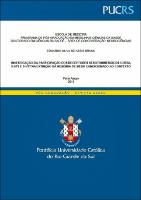| Share record |


|
Please use this identifier to cite or link to this item:
https://tede2.pucrs.br/tede2/handle/tede/8817| Document type: | Tese |
| Title: | Investigação da participação dos receptores serotoninérgicos 5-HT5A, 5-HT6 e 5-HT7 na extinção da memória de medo condicionado ao contexto |
| Author: | Assis Brasil, Eduardo Silva de  |
| Advisor: | Izquierdo, Ivan Antônio |
| First advisor-co: | Myskiw, Jociane de Carvalho |
| Abstract (native): | As memórias de medo podem levar a comportamentos defensivos exagerados em resposta a ameaças, como ocorre no Transtorno de Estresse Pós-Traumático (TEPT). A extinção, novo aprendizado que se sobrepõe à memória original e inibe sua evocação, pode ser útil para restringir a expressão das memórias de medo a situações adequadas. O hipocampo e a amígdala basolateral (ABL) são estruturas essenciais para que ocorra a extinção. Esse processo pode ser modulado por diferentes fármacos e neurotransmissores, como por exemplo, a serotonina. O sistema serotoninérgico possui receptores localizados em diversas áreas no cérebro e seu papel é bem documentado em diversas tarefas comportamentais. Sabe-se que os receptores mais recentementes descritos 5-HT5A, 5-HT6 e 5-HT7 estão relacionados com a formação de alguns tipos de memória, entretanto nada se sabe sobre a participação desses receptores no processo de extinção da memória de medo. Portanto este estudo visa investigar o papel dos receptores 5-HT5A, 5-HT6 e 5-HT7 na extinção da memória de medo condicionada ao contexto. Para isso, ratos Wistar machos com cânulas implantadas na região de CA1 do hipocampo ou ABL foram submetidos ao protocolo de extinção da memória de medo condicionado ao contexto e receberam infusões de agonistas e antagonistas dos receptores 5-HT5A, 5-HT6 e 5-HT7 imediatamente ou 3h após a extinção e testados 24h depois. Quando os farmacos foram infundidos em CA1 imediatamente ou 3h após a extinção, os animais não apresentaram diferença em relação ao grupo controle. Entretanto, quando os antagonistas dos receptores 5-HT5A e 5-HT7 foram infundidos imediatamente ou 3h após a extinção na ABL foi visto uma facilitação no processo de extinção, esse efeito também foi visto quando infundido o antagonista 5-HT6 apenas imediatamente após a extinção na ABL, já os grupos que receberam os agonistas desses receptores não foram diferentes do grupo controle. Concluindo, o bloqueio dos receptores 5-HT5A, 5-HT6 e 5-HT7 na ABL, mas não na região CA1 do hipocampo, foi capaz de facilitar a consolidação da extinção. |
| Abstract (english): | Fear memories can lead to exaggerated defensive behavior in response to threats, such as Post Traumatic Stress Disorder (PTSD). Extinction is the learned inhibition of retrieval, it may be useful in restricting the expression of fear memories to appropriate situations. The hippocampus and basolateral amygdala (ABL) are essential for extinction to occur. This process can be modulated by different drugs and neurotransmitters, for example, serotonin. The serotonergic system has receptors located in several areas in the brain and its role is well documented in various behavioral tasks. It is known that the most recently described receptors 5-HT5A, 5-HT6 and 5-HT7 are related to the formation of some types of memory, however the role of these receptors in the process of extinction of fear memory remains unknown. Therefore, this study aims to investigate the role of 5-HT5A, 5-HT6 and 5-HT7 receptors in the extinction of context-conditioned fear memory. For this, male Wistar rats with cannulas implanted in the CA1 region of the hippocampus or ABL were submitted to the context-dependent fear memory extinction protocol and received infusions of agonists and antagonists of the 5-HT5A, 5-HT6 and 5-HT7 receptors immediately or 3 hours after extinction and tested 24 hours later. When the drugs were infused in CA1 immediately or 3 h after extinction training, the animals did not present difference in relation to the control group. However, when 5-HT5A and 5-HT7 receptor antagonists were infused immediately or 3 h after extinction training in the ABL, the process of extinction was facilitated, this effect was also seen when infused 5-HT6 antagonist only immediately after extinction training in the ABL, the groups that received the agonists of these receptors did not differ from the control group. In summary, the antagonists of the 5-HT5A, 5-HT6 and 5-HT7 receptors in the ABL, but not in the CA1 region of the hippocampus, was able to facilitate de extinction consolidation. |
| Keywords: | Memória Medo Condicionado ao Contexto Extinção Serotonina Hipocampo Amígdala Memory Conditioned Fear Extinction Serotonin Hippocampus Amygdala |
| CNPQ Knowledge Areas: | CIENCIAS DA SAUDE::MEDICINA |
| Language: | por |
| Country: | Brasil |
| Publisher: | Pontifícia Universidade Católica do Rio Grande do Sul |
| Institution Acronym: | PUCRS |
| Department: | Escola de Medicina |
| Program: | Programa de Pós-Graduação em Medicina e Ciências da Saúde |
| Access type: | Acesso Aberto |
| Fulltext access restriction: | Trabalho não apresenta restrição para publicação |
| URI: | http://tede2.pucrs.br/tede2/handle/tede/8817 |
| Issue Date: | 26-Feb-2019 |
| Appears in Collections: | Programa de Pós-Graduação em Medicina e Ciências da Saúde |
Files in This Item:
| File | Description | Size | Format | |
|---|---|---|---|---|
| Eduardo_Silva_de_Assis_Brasil.pdf | EDUARDO_SILVA_DE_ASSIS_BRASIL_TES | 1.94 MB | Adobe PDF |  Download/Open Preview |
Items in DSpace are protected by copyright, with all rights reserved, unless otherwise indicated.




